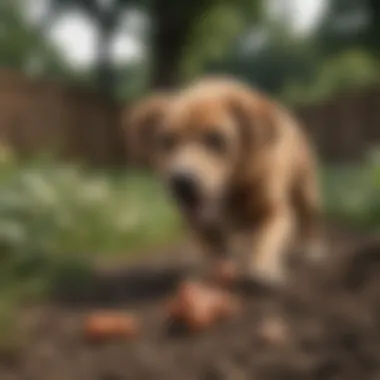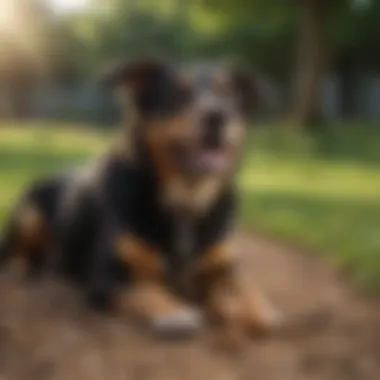Expert Guide: Effective Ways to Stop Your Dog from Digging Up Your Lawn


Animal Behavior & Psychology
When it comes to understanding why your dog engages in the behavior of digging up your lawn, delving into their natural behavior and psychology is key. Dogs are social animals with a rich history of coexisting with humans. Their behavior is influenced by a myriad of factors, including their innate instincts, learned behaviors, and interactions with their environment. By unraveling the intricacies of your dog's behavior and psychology, you can effectively address and modify their digging habits.
Triggers and Motivations
Digging is a natural behavior for dogs that can be triggered by various motivators. Some common reasons for this behavior include seeking attention, exploring scents, attempting to escape, creating a comfortable resting spot, burying prized possessions, or simply having excess energy to burn. Understanding what triggers your dog to dig is crucial in implementing targeted strategies to discourage this behavior.
Environmental Enrichment and Mental Stimulation
Providing your dog with sufficient mental and physical stimulation is imperative to curbing their digging tendencies. Dogs require regular exercise, interactive play, and mental challenges to stay engaged and content. By ensuring that your dog's environment is enriched with toys, puzzles, and engaging activities, you can redirect their focus away from destructive digging towards more constructive and fulfilling behaviors.
Positive Reinforcement and Training Techniques
Effective training methods play a pivotal role in modifying your dog's behavior. Positive reinforcement, which involves rewarding desired behaviors, is a powerful tool in encouraging your dog to abandon their digging habit. Consistency, patience, and clear communication are essential components of successful training. By establishing clear boundaries, redirecting negative behavior, and rewarding positive actions, you can guide your dog towards more desirable behaviors.
Behavioral Modification Strategies
In cases where digging persists despite training efforts, implementing specific behavioral modification strategies may be necessary. Utilizing deterrents such as commercial sprays, uncomfortable textures, or barriers can dissuade your dog from continuing their digging escapades. Creating designated digging areas with loose soil or sand can also provide an outlet for your dog's natural instincts in a controlled manner, minimizing the impact on your lawn.
Comprehensive Approach and Continued Monitoring
Addressing your dog's digging behavior requires a holistic approach that encompasses understanding the underlying motivations, providing adequate stimulation, employing effective training methods, and implementing targeted modifications. It is essential to consistently monitor your dog's progress, adapt strategies as needed, and reinforce positive behaviors. By taking a proactive and attentive stance towards managing your dog's behavior, you can foster a harmonious relationship between your pet and your lawn.
Understanding the Root Cause of Digging
Digging is a common behavior among dogs that can have various underlying reasons. Understanding these root causes is crucial in addressing and preventing this behavior effectively. By delving into the motivators behind digging, pet owners can tailor their interventions to meet their dog's specific needs, leading to a more harmonious relationship between the pet and the garden. Recognizing the importance of identifying these cues and triggers sets the foundation for implementing successful strategies to deter excessive digging.
Natural Instincts


Digging for Shelter
Digging for shelter is an innate behavior rooted in a dog's natural instincts. Dogs may dig to create a comfortable resting place or a cool spot to escape the heat. This behavior harkens back to their ancestral habits of burrowing for safety and protection. Understanding the role of digging for shelter in a canine's behavior repertoire is essential for providing suitable alternatives. While this behavior may offer comfort to dogs, it can wreak havoc on a well-manicured lawn.
Exploration and Play
Exploration and play are fundamental aspects of a dog's life, contributing to their mental and physical well-being. Dogs often engage in digging as part of their exploratory behavior, uncovering scents, textures, and hidden treasures in the soil. This activity serves as a form of enrichment and entertainment for canines, stimulating their senses and cognitive skills. Despite its playful nature, excessive digging in the pursuit of exploration can lead to damage in the yard and create frustration for owners striving to maintain a pristine lawn.
Boredom and Lack of Stimulation
Insufficient Exercise
Insufficient exercise is a primary driver of behavioral issues in dogs, including excessive digging. Dogs require regular physical activity to expend their energy and maintain their overall health. Without adequate exercise, dogs may resort to digging as a means to alleviate boredom and pent-up energy. Addressing this aspect involves incorporating daily walks, interactive play sessions, and engaging activities to provide ample outlets for physical exertion, curbing the urge to dig excessively.
Mental Stimulation
Mental stimulation is equally critical in fulfilling a dog's cognitive requirements and preventing undesirable behaviors like digging. Dogs thrive on mental challenges that keep their brains active and engaged. Lacking mental stimulation can lead to boredom, stress, and destructive behaviors such as excessive digging. Introducing puzzle toys, obedience training, and interactive games can help stimulate a dog's mind, reducing the likelihood of resorting to digging as a source of entertainment or mental engagement.
Creating a Dog-Friendly Yard
In the quest to stop your dog from digging up your lush lawn, focusing on creating a dog-friendly yard emerges as a pivotal strategy. This section delves into the essence of offering your furry companion a conducive environment that caters to their natural instincts and needs. By establishing a dog-friendly yard, you not only address the root cause of your pet's digging behavior but also enhance their overall well-being. It necessitates thoughtful consideration of elements such as designated digging areas, interactive toys, and ample space for physical and mental exercise. Designing a space that resonates with your dog's instincts and preferences fosters a harmonious relationship between your pet and your garden.
Designated Digging Area
Choosing the Right Spot:
Selecting the ideal location for a designated digging area is imperative in the pursuit of deterring your dog from disrupting your lawn. The chosen spot should be easily accessible to your pet, preferably in a secluded area to instill a sense of privacy. Opting for an area with loose soil facilitates easy digging for your dog, steering them away from targeting your meticulously landscaped turf. The main advantage of choosing the right spot lies in channeling your pet's digging urges towards a designated zone, thereby preserving the integrity of your garden. However, a potential disadvantage could be the need for regular monitoring and maintenance of this area to ensure its effectiveness in curbing unwanted digging behavior.
Encouraging Usage:
Encouraging your dog to utilize the designated digging area is central to the success of this behavioral intervention. Employing positive reinforcement techniques such as treats or praises when your pet digs in the designated spot reinforces this desirable behavior. By making the designated area appealing through the burying of toys or treats, you enhance its attractiveness to your dog, thereby steering them away from other areas of your yard. The advantage of encouraging usage lies in redirecting your pet's natural digging instincts towards a designated zone, minimizing the chances of them targeting your lawn. On the flip side, a potential downside could be the initial effort required to train your dog to use the designated area consistently.


Training and Behavioral Solutions
Training and Behavioral Solutions play a pivotal role in addressing and curbing your dog's propensity for digging up your pristine lawn. It is crucial to understand that canines have complex behavioral patterns, and addressing these behaviors requires a tailored approach. By focusing on Training and Behavioral Solutions, you can instill positive habits and deter destructive tendencies effectively. Training not only fosters a strong bond between you and your furry companion but also promotes a harmonious living environment.
Positive Reinforcement
Positive Reinforcement is a cornerstone of behavioral training for dogs. By rewarding good behavior, you reinforce desirable actions, encouraging your dog to repeat them. Rewarding Good Behavior entails acknowledging and praising your dog when they exhibit the desired behavior, such as refraining from digging in the yard. This method underscores the importance of positive associations and motivates your pet to engage in approved activities. Despite its popularity, it is essential to note that consistency is key when implementing this technique. Consistent rewards help solidify the desired behavior and create lasting positive habits.
Consistent Commands and Corrections
Clear Instructions are essential when training your furry friend. By offering precise and consistent commands, you provide clarity and guidance, making it easier for your dog to understand your expectations. Clear instructions help your pet grasp what is expected of them, leading to effective communication and cooperation. Redirecting Attention is another crucial aspect of behavioral training. By redirecting your dog's focus from unwanted behavior to more appropriate activities, you help steer them away from destructive habits. This approach involves diverting your pet's attention whenever they engage in undesirable behavior, gradually shifting their focus to more positive outlets.
Professional Training and Consultation
Sometimes, seeking Expert Advice is necessary to address complex behavioral issues effectively. Consulting with a professional trainer or behaviorist can provide valuable insights and strategies tailored to your dog's specific needs. Seeking Expert Advice ensures that you receive expert guidance and support, enhancing the effectiveness of your training efforts. Additionally, Behavior Modification Plans offer structured frameworks for addressing and modifying unwanted behaviors. These plans are designed to target specific issues and implement targeted solutions, helping your dog unlearn destructive habits and develop more appropriate behaviors.
Environmental Deterrents
Environmental deterrents play a crucial role in the efforts to prevent your dog from digging up your lawn. By utilizing physical barriers, odors, and tastes that discourage digging behavior, you can effectively protect your garden while fostering a safe environment for your pet. These deterrents serve as a non-harmful way to deter your dog from engaging in destructive digging habits, promoting a harmonious coexistence between your canine companion and your outdoor space.
Physical Barriers
Physical barriers are essential tools in deterring dogs from digging up your lawn. They create a clear boundary that dissuades your pet from accessing forbidden areas or engaging in destructive behavior. Among the various physical barrier options available, fencing stands out as a popular choice for its ability to restrict access and provide a visible boundary for your dog. Fencing options vary in materials, heights, and designs, allowing you to select the most suitable option based on your specific requirements. While fencing can be a highly effective deterrent, it is essential to consider maintenance requirements and visual impact when choosing this option for your garden.
Fencing Options
Fencing options, such as chain link, wood, or metal fences, offer a durable and long-lasting solution for safeguarding your lawn. Their sturdy construction provides a robust barrier that prevents easy access for your dog while enhancing the overall security of your property. Chain link fencing, known for its affordability and visibility, offers a practical choice for homeowners seeking a cost-effective yet effective solution to deter digging behavior.
Underground Installations


Underground installations, including electronic pet containment systems or wire mesh barriers buried beneath the surface, offer discrete deterrence to prevent your dog from digging in specific areas. These installations provide an invisible yet effective barrier that deters your pet without impacting the aesthetic appeal of your garden. However, it is essential to train your dog properly to respect these underground boundaries to ensure their effectiveness in curbing digging behaviors.
Odor and Taste Aversion Techniques
Odor and taste aversion techniques utilize scents and flavors that are unpleasant to dogs, discouraging them from digging in your lawn. These techniques offer a natural and non-invasive approach to deter unwanted behavior while protecting your garden from damage. By strategically using natural repellents and commercial solutions, you can create an environment that is unappealing to your dog's sense of smell and taste, effectively redirecting their digging energy towards more appropriate activities.
Natural Repellents
Natural repellents, such as citrus peels, vinegar, or cayenne pepper, emit scents that repel dogs without causing harm. These eco-friendly options provide a safe and effective way to deter digging behavior while adding a natural fragrance to your garden. By dispersing these repellents in targeted areas, you can create an invisible barrier that signals to your dog that digging is off-limits.
Commercial Solutions
Commercial solutions, including bitter apple sprays or proprietary odor repellents, offer ready-to-use options for deterring your dog from digging up your lawn. These products are formulated to deliver strong odors or tastes that are unappealing to dogs, effectively discouraging them from destructive behavior. While commercial solutions offer convenience and quick application, it is important to choose products that are safe for pets and environmentally friendly to ensure the well-being of your dog and the surrounding ecosystem.
Consistency and Patience
Consistency and patience play a pivotal role in curbing your dog's digging habits. Establishing a routine that your furry friend can rely on is key. This consistency helps create a sense of security for the dog, reducing anxiety-driven behaviors. Patience becomes imperative as behavior change takes time and effort. Developing a routine that incorporates daily monitoring and reinforcement of rules is essential. By remaining patient and consistent, you can set clear expectations for your pet and uphold boundaries effectively. In the long run, this approach fosters a deeper bond between you and your canine companion.
Establishing a Routine
Daily Monitoring
Daily monitoring involves keeping a close eye on your dog's behavior and interactions with the yard. This aspect allows you to observe patterns and triggers that lead to digging behavior. By consistently monitoring your pet's activities, you can identify early signs of digging and address them promptly. Daily monitoring also helps in assessing the effectiveness of your training and behavior modification strategies. It provides valuable insights into your dog's progress and allows you to make necessary adjustments to your approach.
Reinforcement of Rules
Reinforcing rules is crucial in establishing boundaries for your dog. Consistent reinforcement helps your pet understand which areas are off-limits for digging. By rewarding positive behavior and redirecting unwanted actions, you reinforce the rules of engagement with your dog. This aspect of training is essential in instilling good habits and preventing destructive behavior. While it requires patience and repetition, the results of consistent rule reinforcement are well worth the effort.
Managing Expectations
Time for Improvement
Allowing time for improvement is an integral part of the process. Rome wasn't built in a day, and behavior change doesn't happen overnight. Setting realistic timelines for progress is crucial to avoid frustration. Providing your dog with the opportunity to learn and adapt at their own pace fosters a positive learning environment. Time for improvement allows both you and your pet to grow together, strengthening your bond and trust.
Celebrating Progress
Celebrating small victories is key to maintaining motivation and momentum. Recognizing and acknowledging your dog's progress encourages continued good behavior. It reinforces positive habits and creates a sense of achievement for both you and your pet. Celebrating progress can range from verbal praise to small rewards, emphasizing the importance of consistent effort. By celebrating milestones, you create a positive reinforcement cycle that enhances your dog's learning experience.







